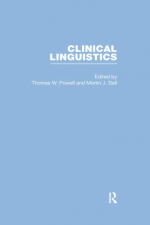Tab Article
Clinical Linguistics involves the application of linguistic theories and procedures to the study, characterization, and treatment of communicative disorders. Although linguists have long applied their science to a variety of language problems, Clinical Linguistics did not emerge as an autonomous discipline until the publication of Crystal’s influential Clinical Linguistics in 1981. Despite its youth, this specialist area has quickly evolved into a highly productive field of inquiry. From its inception, Clinical Linguistics has had a strong international presence. The field is interdisciplinary, with relevance to theoretical and applied linguistics, speech and language therapy, psychology, and education.
The Clinical Linguistics literature has been especially eclectic, appearing in diverse scientific and professional publications. Many of these sources have limited circulation, a fact that challenges individuals and research libraries to maintain a comprehensive collection. The primary aim of this new four-volume Routledge collection is to assemble a representative library of the seminal and the best cutting-edge Clinical Linguistics scholarship. Classic works, as well as state-of-the-art data-based and philosophical articles, are included.
Volume I is focused on the foundations of Clinical Linguistics, particularly its conceptual, historic, and theoretical bases; Volume II examines clinical phonetics and speech measurement, and the phonological analysis of disordered speech. Volume III, meanwhile, concentrates on Clinical Linguistics and language disorders. The final volume in the collection is organized around the educational and medical application of Clinical Linguistics, as well as emerging issues and controversies.


